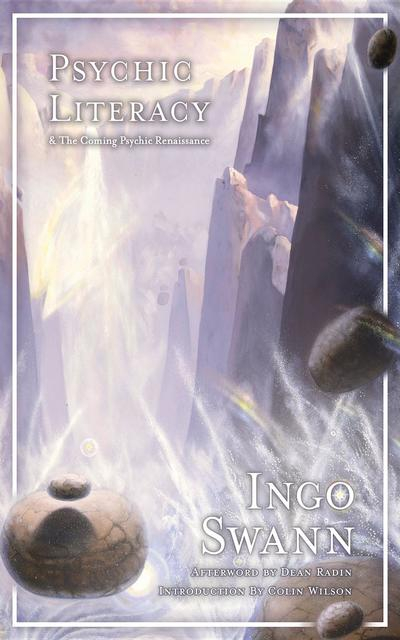
Reviewed by Nemo C. Mörck
Psychic Literacy and the Coming Psychic Renaissance is a previously unpublished book manuscript found among the late Ingo Swann’s papers, which resides at: University of West Georgia Special Collections. Today Swann is perhaps best known for his early involvement with the Star Gate program, but he was also an artist and an author. In the Introduction Colin Wilson describes Swann as “one of the most intelligent and articulate” (p. 4) psychics in the world. This alone would have made Swann’s books worth reading. Swann was involved with parapsychology from 1969, often as a participant in experiments, and he read widely. Swann wrote Psychic Literacy in the late 1980s (Wilson’s Introduction is dated 1989) and optimistically noted: “the whole of society, including science, is verging on recognizing not only the existence of psychic stuff but the role it plays in human life” (p. 8). Some still believe this to be the case.
Psychic Literacy is a personal book in which Swann generously shares recollections, observations, frustrations, and thoughts about psychic phenomena. Particularly noteworthy are the long sections about precognition and more surprisingly astrology (Swann was an astrologer). Although, Swann seems to have hoped for a change he was not naive and notes that “… being considered kooky is part of the cross anyone deeply identified with psychic research must bear in the United States” (p. 29). He also acknowledges that the lack of repeatability and theories “that remotely fits in with accepted theories” (p. 44) contribute to making parapsychology remain a controversial subject. However, Swann remarks “we have a society which on the one hand ridicules psychic stuff, but on the other hand gobbles up relevant insights regarding it” (p. 69). In this context he notes that books such as The Magic of Believing by Claude M. Bistol, Success Through a Positive Mental Attitude by Napoleon Hill and Clement Stone, and Creative Visualization by Shakti Gawain were all best sellers. It is not hard to come up with more modern examples (the author Mitch Horowitz delves into this kind of literature). Swann relates that some successful persons rely on their intuition or have astrologers/psychics on retainer. Nevertheless,
… if telepathy, clairvoyance, precognition, and, even intuition, were processes that could be developed, then we the clever things we are, would have achieved wide-spread development of them long ago (p. 104; emphasis in original).
It is evident that Swann pondered on why this is not the case but he did not arrive at a simple answer. In his search for answers he looks at the histories of the palm reader Count Louis Hamon, best known as Cherio, and the astrologer Walter Gorn Old, best known as Sepharial. He also writes about the notorious Nostradamus. Swann was clearly also interested not only in astrology, but also palmistry and numerology. He does not delve into these latter topics, but some sections concern astrological analyses.
The book is a hodgepodge. That said, Swann appears to have been particularly intrigued by precognition, perhaps partly due to some personal experiences that he shares. One chapter concern healing, including the healings in Lourdes (Swann focus on the healing of John Traynor). D. J. West’s (1957) sceptical treatment of healings in Lourdes (made possible thanks to a grant from the Parapsychology Foundation) did not to impress Swann. Like others in the parapsychology community Swann thought that it had been proven that we are all interconnected.
Like the fish swimming in water, the last thing fish will probably notice is the water. We are swimming in a sea of physical and psychic linkages, an environment of connections so omnipresent that unless we turn out attention to deliberately trying to perceive the environment in detail we probably will not (pp. 252-253; emphasis in original)
In addition, Swann was intrigued by the possible relevance of geomagnetic fields to psychic phenomena. His interest was apparently the cause of Michael Persinger’s subsequent research into this topic. Swann’s interest appears to have been sparked by research in the Soviet Union. Scientists there had a different perspective compared to parapsychologists in the West and tended to think of psychic phenomena as involving energies and fields.
... the Soviet research was stipulating that on many levels beneath or outside of the conscious, intellectual mind, living organisms radiated and/or exchanged information via electrical or magnetic “fields.” What we in the West call “gifted psychics” are only so gifted because they have acquired more conscious participation with what essentially is a psychic-biological heritage inherent in our bio-genetic makeup (pp. 26-27).
The book ends with an Afterword by Dean Radin in which he touches on what has happened since Swann wrote his manuscript. There is also a Bibliography and a Glossary, in which Swann explains terms such as information-glut:
The present-day proliferation of information which seems increasingly to exceed our individual, social, scientific, or cultural capabilities of intellectually being able to assimilate or constructively integrate it, leading to a variety of intellectual breakdowns (p. 335).
Swann was interested in the meaning of terms, but his occasional detours in the book are not disturbing. The book is a hodgepodge, but it is easy to dip in and out. It is not surprising that Swann did not mange to integrate everything in his Conclusion, in which he remarks:
The realization that psychic stuff is important and useful to human survival is perhaps the only realization that will stimulate a true and accurate interest in achieving psychic literacy (p. 322)
References
West, D. J. (1957). Eleven Lourdes Miracles. London: Gerald Duckworth.

